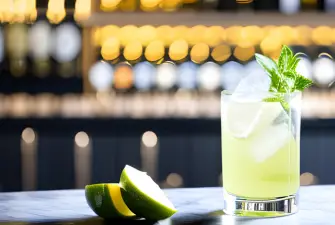Exploring the Distinct Flavor Differences of Gin vs Dry Gin
Gin and Dry Gin each offer unique taste experiences. London Dry Gins, without added sugars, highlight natural botanicals like juniper and citrus, giving a robust, herbal profile. Distinctive botanical choices in gin craft its crisp flavors.
Production methods, from distillation to ingredient selection, shape the complexity of gin.
Investigating different gin varieties reveals a range of flavor profiles waiting to be discovered. When pairing gin, its botanical complexity shines, enhancing seafood dishes and classic cocktails.
Main Points Covered Below
- London Dry Gin features natural botanicals like juniper and citrus for a robust flavor.
- Gin types offer diverse palates a range of flavors due to distinct botanical profiles.
- Distillation methods like pot still and column still impact the taste and aroma of gin.
- Gin varieties provide a sensory journey exploring intricate botanical blends.
- Gin’s botanical complexity complements seafood dishes and classic cocktails like Martini and Gin and Tonic.
Gin Vs London Dry Gin: Flavor Differences
When comparing gin to London Dry Gin, one can immediately taste the distinctive difference in flavors. London Dry Gins, recognized for their pure and unadulterated taste, stand out due to the guarantee of added sugars.
This lack of sweetness allows the natural botanicals like juniper, coriander seeds, and citrus peel to shine through, creating a more herbal and robust profile.
The guarantee of artificial flavorings in London Dry Gin not only enhances its authenticity but also makes it a preferred choice for those seeking a more refined and classic gin experience.
London Dry Gins, with their strict production standards requiring bottling in England, guarantee a level of quality that sets them apart from regular gins. The guarantee of added sugars in London Dry Gin not only makes it less cloying but also enhances its versatility for mixing, particularly with tonic water.
This emphasis on natural botanicals and traditional production methods gives London Dry Gin its unique and sophisticated flavor profile.
How Does London Dry Gin Compare to Regular Gin in Terms of Flavor?
London dry gin history dates back to the 19th century when it became known for its crisp, dry flavor. Compared to regular gin, London dry gin is characterized by its intense juniper flavor and less sweetness. It’s also known for its use of natural botanicals and strict production methods.
Distinct Botanical Profiles in Gin
Exploring the diverse botanical profiles in gin reveals a spectrum of unique flavors and aromas that distinguish one brand from another. The selection of botanicals like juniper, coriander, citrus peel, and angelica root plays a vital role in shaping the distinct character of each gin variety.
For instance, London Dry Gin stands out for using natural botanicals such as juniper berries without any artificial additives or sweeteners, contributing to its traditional and crisp flavor profile. The careful consideration of botanical selection and the meticulous distillation methods employed further enhance the aroma, taste, and complexity of different gin types.
The interplay between these botanicals and distillation techniques leads to a fascinating array of flavors that cater to diverse palates. With the botanical diversity found in various gins, you gain a deeper appreciation for the intricate nuances and sensory experiences offered by each brand.
Production Techniques Shaping Gin Flavors
Production techniques greatly influence the diverse flavor profiles of gin, showcasing the artistry and innovation in crafting this beloved spirit.
- Distillation methods like pot still, column still, and vacuum distillation are essential in determining the final taste of gin. Each method imparts distinct characteristics to the spirit, ranging from bold and juniper-forward to smooth and citrusy notes.
- Botanical choices, such as juniper, coriander, and citrus peels, are carefully selected to create the foundation of gin’s flavor. These botanicals, along with additional ingredients like lavender and cardamom in contemporary gins, contribute to the complexity and uniqueness of each blend.
- Production techniques such as cold compounding, barrel aging, and small-batch distillation further enhance the flavor spectrum of gin. These methods allow for experimentation and innovation, leading to a wide range of flavor profiles that cater to diverse preferences and taste preferences.
Crafting gin is truly an art form, where the meticulous combination of distillation methods, botanical choices, and production techniques results in the vast array of flavors that gin enthusiasts enjoy.
Sensory Exploration of Gin Varieties
Gin varieties offer a sensory journey into a world of diverse flavors, inviting enthusiasts to investigate the intricate nuances of botanical blends through aroma, taste, and mouthfeel.
Exploring different gins, like London Dry Gin and Plymouth Gin, is a delightful adventure of discovering how various botanicals, such as coriander seeds, citrus peels, and angelica root, contribute to the complex flavor profiles.
During gin tasting sessions, participants can engage in a comparative analysis, discerning the impact of botanical choices on taste and aroma. These sessions provide a platform to appreciate the craftsmanship behind each gin variety, showcasing the artistry of distillation and blending techniques.
Below is a table illustrating some common botanicals found in different gin varieties:
| Botanicals | Description | Common Varieties |
|---|---|---|
| Juniper Berries | Contribute a piney, resinous flavor | London Dry Gin |
| Citrus Peels | Add bright, zesty notes | Plymouth Gin |
| Coriander Seeds | Provide a spicy, citrusy undertone | Various Gin Styles |
Through these tasting experiences, individuals can discover the secrets of gin flavors, understanding how each botanical plays a vital role in shaping the overall taste profile.
Pairing Gin: Food and Cocktails Synergies
I love the art of pairing gin with food and cocktails reveals a world of essential flavor synergies is waiting to be discovered.
- Gin’s botanical flavors, including juniper, citrus, and herbs, offer an invigorating and aromatic complement to seafood dishes, enhancing the overall dining experience.
- Classic gin cocktails like the Martini or Gin and Tonic not only showcase the botanical complexity of gin but also pair exquisitely with a variety of cuisines, making them versatile choices for any meal.
- Experimenting with different gin styles in cocktails can elevate the dining experience by balancing flavors and textures, creating a harmonious synergy between the drink and the dish.
Understanding the botanical profile of gin plays an important role in creating these perfect food and cocktail pairings, ensuring a delightful fusion of flavors.
The versatility of gin opens up a world of creative possibilities, allowing for unique and enjoyable combinations that span from light and fresh salads to rich and savory entrees.






